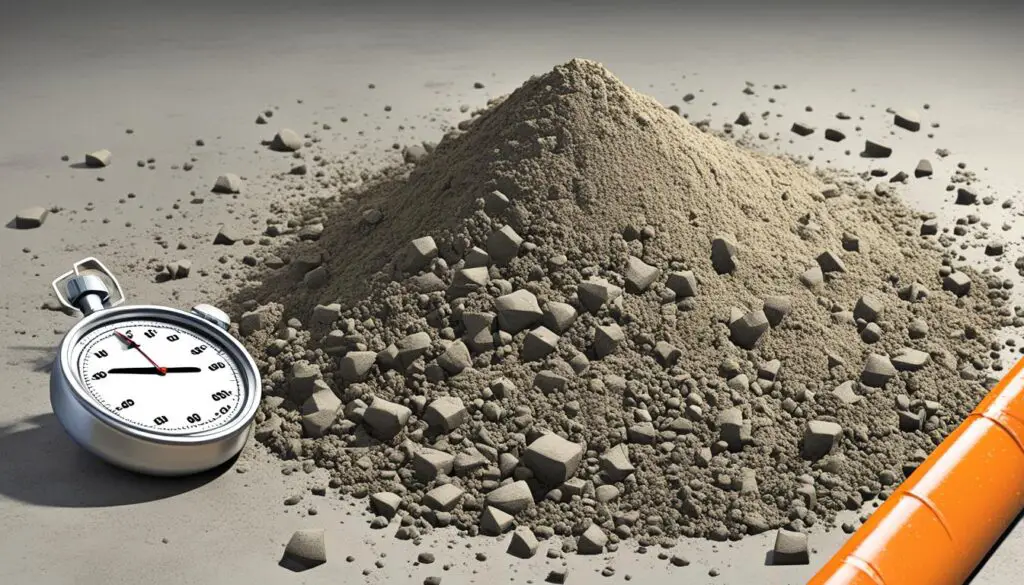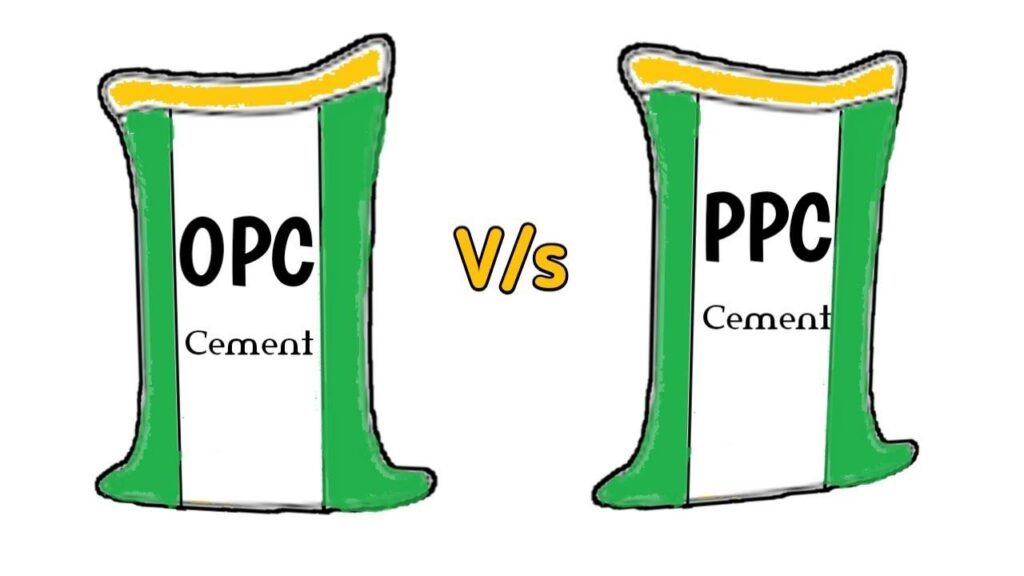When it comes to building durable structures, cement is the foundation that holds everything together. To ensure its strength and stability, it’s important to understand the setting process of cement, specifically the initial and final setting times. Both of these times are crucial for ensuring the structural integrity of cement-based structures.
In this article, we will discuss the differences between the initial and final setting times of cement, as well as the various types of cement available. We will also delve into the factors that can influence the setting time of cement, and why it’s important to consider them during construction.

Key Takeaways:
- Understanding the setting process of cement is crucial for building durable structures.
- The initial and final setting times of cement are both important for ensuring its structural integrity.
- The factors that can influence the setting time of cement should be considered during construction.
- There are different types of cement available, each with its specific setting characteristics.
- Measuring and monitoring the setting times of cement is essential for achieving desired results in construction projects.
Explaining the Setting Process of Cement
In the setting process of cement, there are three crucial stages to understand: hydrolysis and hydration, colloidisation, and crystallization. Hydrolysis is the process that occurs when water reacts with cement, causing chemical breakdown and forming calcium-silicate-hydrate (C-S-H) and calcium hydroxide (CH). The hydration stage occurs when the C-S-H and CH compounds continue to react with water, producing heat and filling the gaps between cement particles. Colloidisation takes place when the C-S-H compounds start to condense and form a gel-like substance. Finally, crystallization takes place, where the C-S-H compounds continue to condense and become more dense, resulting in a solid material.
The reactions that take place during these stages are complex and require specific conditions to occur. As a result, the process of cement setting can take several hours to several days depending on the circumstances, such as temperature, humidity, and cement type. It is important to note that the setting process and the resulting strength of cement are not only dependent on the chemical reactions that occur but also on the curing process that follows.

Hydrolysis and Hydration
Hydrolysis is the critical first stage of the setting process, as water reacts with the cement compound to form the necessary compounds for the setting. During this stage, the initial reaction between water and calcium aluminate and calcium silicate compounds takes place. This initial reaction produces calcium hydroxide (CH) and calcium silicate hydrate (C-S-H) gels. Following this, the hydration stage begins, where the C-S-H and CH gels continue to react with water slowly.
Colloidisation
As the C-S-H and CH gels continue to react with water, colloidisation occurs, where the gels begin to condense and form a gel-like substance. During this stage, the gels begin to fill the gaps between cement particles, making it more difficult for water to escape. Once the colloidisation stage is complete, the mixture becomes much denser, and the non-reacted cement particles become isolated.
Crystallization
During crystallization, the C-S-H gels begin to condense further and become more dense, forming a solid material. The CH gels also continue to consolidate and harden, which contributes to the strength of the final product. The crystallization stage is the final stage of the setting process and the complete reaction results in a solid material with the desired strength and characteristics.
Understanding the Initial Setting Time of Cement
When cement is mixed with water, it begins to set and harden, gradually gaining strength. The time it takes for the mixture to reach a specific level of rigidity is known as the initial setting time of cement.
Various factors can influence the initial setting time of cement, such as the cement type, water temperature, humidity, and the amount of water used. For instance, cement with higher proportions of gypsum has a shorter initial setting time. Additionally, a higher water temperature accelerates the setting process, while higher humidity can slow it down.
It is essential to understand the initial setting time of cement to ensure that it is adequately mixed and applied within the specified timeframe. If cement sets too quickly, it can result in a weak structure. On the other hand, if it takes too long to set, it can affect the structural strength and safety of the building.

Understanding the Final Setting Time of Cement
After the initial setting time, the cement goes through the final setting time. This is the point at which it achieves full hardness and can be considered safe to handle without compromising its structure. The final setting time of cement varies depending on several factors, including:
– Type of cement
– Ambient temperature
– Water-cement ratio
– Chemical composition of cement
– Fineness of cement
– Use of additives
Factors such as these can influence the rate at which the cement sets and can affect the final setting time of cement. For instance, higher temperatures can cause the cement to set faster, while increasing the water-cement ratio can lengthen the setting time.
To ensure the correct final setting time of cement is reached, it is important to follow the manufacturer’s instructions and use the right amount of water and cement for the specific type of project. This will guarantee that the cement sets correctly and provide the necessary structural integrity for the project.

Factors Influencing Setting Time of Cement
The setting time of cement can be influenced by several external factors that can affect the chemical reactions occurring during the setting process. Understanding these factors is crucial for ensuring that the cement sets properly and achieves the desired strength and stability.
1. Temperature
The setting time of cement can be affected by temperature. Higher temperatures can accelerate the setting process, while lower temperatures can slow it down. The ideal temperature range for cement setting is between 10°C to 36°C.
2. Humidity
The amount of moisture present in the environment can also play a role in the setting time of cement. High humidity levels can increase the setting time, while low humidity levels can decrease it.
3. Particle Size
The particle size of cement can also influence its setting time. Cement with larger particles tends to set slower than cement with smaller particles.

4. Water-Cement Ratio
The water-cement ratio is another crucial factor that can influence the setting time of cement. A higher water-cement ratio can cause the cement to set faster, while a lower ratio can cause it to set more slowly.
5. Chemical Additives
Chemical additives can also be added to cement to influence its setting time. Some additives can speed up the setting process, while others can slow it down.
6. Type of Cement
The type of cement used can also affect its setting time. Different types of cement, such as Portland cement, rapid hardening cement, and sulfate-resisting cement, have different setting characteristics due to their unique chemical composition.

Significance of Initial and Final Setting Time of Cement
The initial and final setting times of cement play a crucial role in ensuring the structural integrity of cement-based structures. Understanding these setting times is critical for engineers and construction professionals to work effectively with cement and build durable infrastructure.
The initial setting time of cement is the period where the mixture changes from a plastic state to a set state. This occurs due to the chemical reaction that takes place between water and cement. The final setting time, on the other hand, is the time when the cement has fully hardened and becomes resistant to external forces and impacts.
By measuring the initial and final setting times, engineers can determine the appropriate time for curing, formwork removal, and load application. Factors like temperature, moisture content, and cement types can influence these setting times. Therefore, it is critical to monitor and control these factors to ensure the desired setting time is achieved.

Moreover, the initial and final setting times can vary depending on the type of cement. For instance, OPC 33 cement has a longer setting time than OPC 53 grade cement. Therefore, understanding the initial and final setting times of different types of cement and how they impact the construction process is essential for achieving optimal results.
Initial and Final Setting Time of Different Types of Cement
Understanding the initial and final setting times of cement is crucial to ensuring the structural integrity of any construction project. Different types of cement have varying initial and final setting times, depending on their composition and characteristics. In this section, we will provide a comparative analysis of the initial and final setting times for various types of cement, helping readers understand their setting behavior and make informed decisions when choosing the right type of cement for their project.
| Cement Type | Initial Setting Time (mins) | Final Setting Time (hrs) |
|---|---|---|
| OPC 33 Grade | 30-60 | 6-7 |
| OPC 43 Grade | 30-60 | 9-10 |
| OPC 53 Grade | 30-60 | 10-12 |
| PPC | 30-60 | 24-48 |
| Sulfate Resisting Cement | 30-60 | 10-12 |
| Rapid Hardening Cement | 5-8 | 30-40 |
| Portland Slag Cement | 30-60 | 10-12 |
| Masonry Cement | 90-1440 | Not Defined |
Note: These are only approximate values and are subject to variations depending on factors such as temperature, water content, humidity, and atmospheric pressure.
As seen in the table above, different types of cement have varying initial and final setting times. Rapid hardening cement, for example, has a shorter initial and final setting time compared to other cement types, making it ideal for use in time-sensitive projects. On the other hand, PPC has a longer final setting time, making it perfect for large-scale construction projects.
It’s important to note that the setting time of cement can also affect its strength. Cement that sets too quickly or too slowly can result in a weaker structure. Therefore, it’s essential to choose the right type of cement that aligns with the specific project requirements.

Explaining the Initial and Final Setting Time of Each Cement Type
In this section, we will provide detailed explanations of the initial and final setting times for each type of cement mentioned in Section 7. Each section will focus on one type of cement and discuss its specific setting characteristics.
OPC 33 grade
Initial setting time: 30 minutes
Final setting time: 600 minutes
OPC 33-grade cement is commonly used for plastering and finishing purposes. It has a quick initial setting time and extended final setting time, which makes it useful for projects that require more time to complete.

OPC 43 grade
Initial setting time: 30 minutes
Final setting time: 600 minutes
OPC 43 grade cement is ideal for residential and commercial construction projects, as it offers high compressive strength and durability. Its initial and final setting times are similar to OPC 33-grade cement, making it a versatile option for various applications.
OPC 53 grade
Initial setting time: 30 minutes
Final setting time: 600 minutes
OPC 53 grade cement is a high-performance cement that offers exceptional strength and durability. It is commonly used in large-scale infrastructure projects like bridges, dams, and airports. Its initial and final setting times are similar to OPC 33 and 43-grade cement, which allows workers ample time to finish their work.
PPC
Initial setting time: 30 minutes
Final setting time: 600 minutes
PPC or Portland Pozzolana Cement is a widely used cement in residential construction projects. It is made by blending Portland cement and pozzolanic material. It has excellent workability and is known for its low heat of hydration. Its initial and final setting times are similar to OPC 33, 43, and 53-grade cement.
Sulfate resisting cement
Initial setting time: 30 minutes
Final setting time: 600 minutes
Sulfate-resistant cement is a type of cement that is highly resistant to sulfate attacks. It is commonly used in sea structures, sewage treatment plants, and other areas where there is a risk of sulfate exposure. Its initial and final setting times are similar to other cement grades.

Rapid hardening cement
Initial setting time: 4 hours
Final setting time: 24 hours
Rapid-hardening cement is used in construction projects that require quick setting times. Its initial setting time is longer than other types of cement, but it offers exceptional strength and durability with a final setting time of 24 hours. It is commonly used in precast concrete elements and road repairs.
Portland slag cement
Initial setting time: 30 minutes
Final setting time: 600 minutes
Portland slag cement is a type of cement that is made by blending Portland cement with granulated blast furnace slag. It offers excellent workability, durability, and resistance to chemical attacks. Its initial and final setting times are similar to OPC 33, 43, and 53-grade cement.
Masonry cement
Initial setting time: 90 minutes
Final setting time: 1440 minutes
Masonry cement is a type of cement that is used for making mortar for masonry work. Its initial setting time is longer than other types of cement, but it offers superior workability and water retention properties. Its final setting time is longer than other cement types, allowing workers ample time to complete their work.

Conclusion
To sum up, understanding the setting process of cement and the initial and final setting times is crucial for ensuring the structural integrity of cement-based structures. The three stages of hydrolysis and hydration, colloidisation, and crystallization play a significant role in the setting process. Factors such as temperature, humidity, cement type, and water-cement ratio can influence the setting time of cement.
It is essential to note that different types of cement have varying initial and final setting times. While OPC 33 grade and masonry cement have longer initial and final setting times, rapid hardening cement and Portland slag cement have shorter times. It is vital to keep these differences in mind while choosing the appropriate cement for a particular project.
Therefore, this article has provided valuable information on the setting process of cement and the significance of both initial and final setting times. With this knowledge, builders and engineers can ensure the efficient and safe construction of buildings and infrastructure.
Thanks For the Great Attention!
Good Bye & Take Care
Happy Learning




